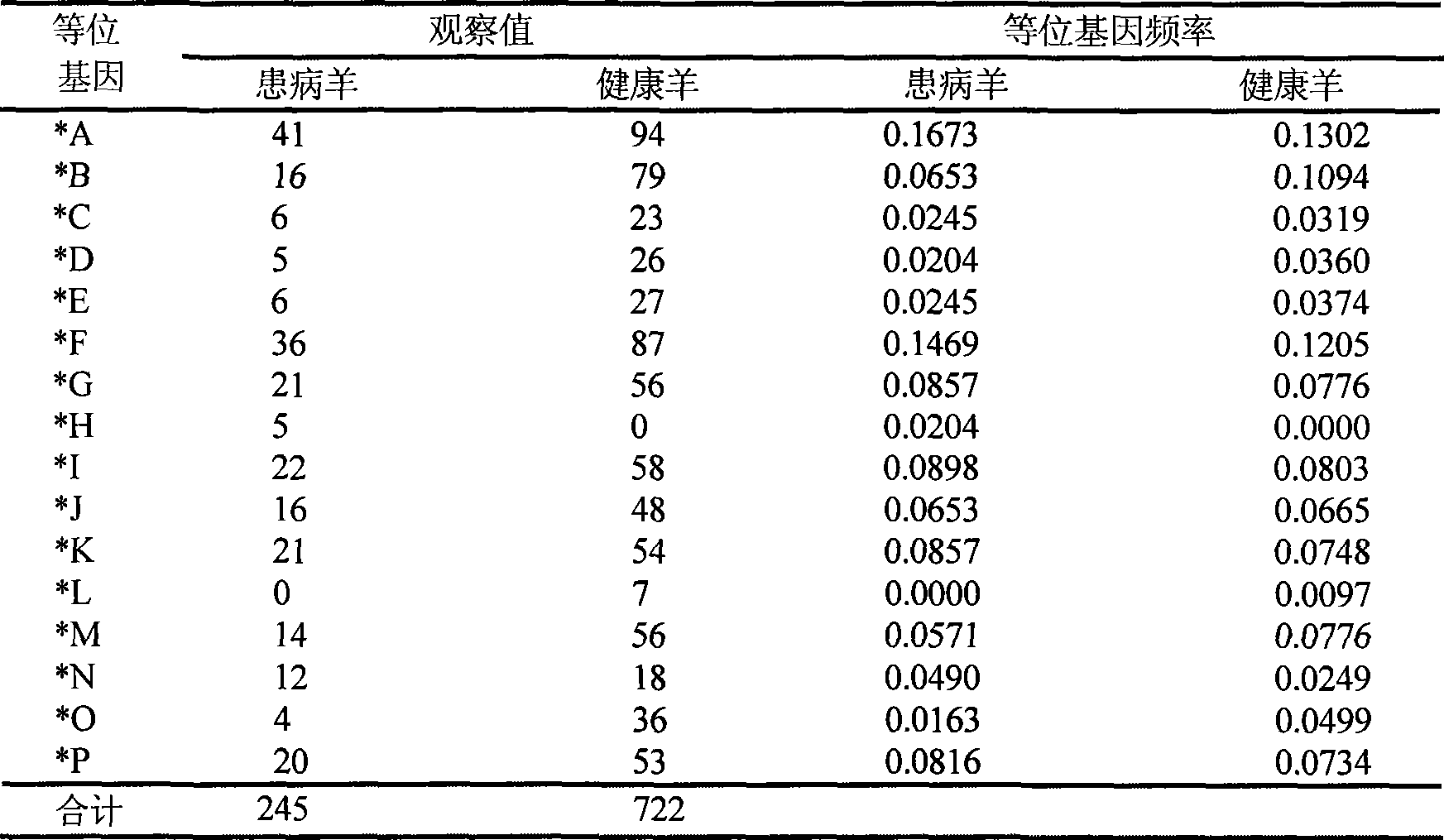Special amplimer for detecting tibetan sheep foot rot resistance allele, detecting agent case and method thereof
A technology of alleles and amplification primers, applied in biochemical equipment and methods, measurement/testing of microorganisms, DNA/RNA fragments, etc., can solve problems such as difficult-to-control diseases and drug residues, and achieve high sensitivity and low cost low effect
- Summary
- Abstract
- Description
- Claims
- Application Information
AI Technical Summary
Problems solved by technology
Method used
Image
Examples
Embodiment 1
[0056] experiment material
[0057] 104 Tibetan sheep were selected from Dashui Breeding Farm in Gannan Tibetan Autonomous Prefecture, Gansu Province, 791 herdsmen's sheep in Luqu County, Gannan Prefecture (223 with foot rot disease), and 72 herdsmen's sheep in Hali Village, Hali Township, Haiyan County, Qinghai Province (22 rats suffering from foot rot), 10 ml of blood was collected from the jugular vein, anticoagulated with ACD, and stored at -20°C. Genomic DNA was extracted from frozen blood samples by phenol-chloroform extraction, dissolved in TE, and stored at 4°C.
[0058] experiment method
[0059] 1. Primer Design and PCR Amplification
[0060] Gene amplification was performed by nested PCR. The size of the amplification product of DQA2-up and DQA2-dn is 828bp, the size of the amplification product of DQA2s-up and DQA2s-dn using the amplification product of DQA2-up and DQA2-dn as a template is 242bp, and the primer sequence is:
[0061] Upstream primer 24bp: DQA2-u...
Embodiment 2
[0081] Embodiment 2: the detection method for the detection of Tibetan sheep foot rot resistance alleles is that the determination steps of Tibetan sheep susceptibility alleles and stronger alleles of resistance are:
[0082] (1) Collect the genomic DNA of Tibetan sheep with normal phenotype and foot rot disease;
[0083] (2) using the above-mentioned specific primers DQA2-up and DQA2-dn to amplify the DNA-specific fragment in step (1);
[0084] (3) using the above-mentioned specific primers DQA2s-up and DQA2s-dn to amplify the PCR product in step (2);
[0085] (4) carry out SSCP detection with the PCR product in step (3);
[0086] (5) each allelic sequence produced in step (4) of cloning and sequencing;
[0087] (6) According to the genotype discrimination result of (4), combined with the phenotype observation data, determine the susceptibility allele and resistance allele of Tibetan sheep foot rot;
[0088] (7) The susceptibility allele for foot rot in Tibetan sheep was d...
Embodiment 3
[0089] Embodiment 3: The detection method for detecting Tibetan sheep foot rot resistance alleles, the specific detection steps are as follows:
[0090] (1) Sample collection: Collect Tibetan sheep with normal phenotype and those suffering from rot, 10ml of jugular vein blood, ACD anticoagulant, and cryopreservation at -20°C;
[0091] (2) Genomic DNA extraction: Genomic DNA was extracted from frozen blood samples by conventional phenol-chloroform extraction;
[0092] (3) Polymerase chain reaction:
[0093] For a 20μL reaction system, the dosage and concentration of the components are: 0.5μL / 10pmol for each of the four primers, 1.2μL / 2.5mm for dNTP, 0.2μL / 2.5U / μL for Taq DNA polymerase, and 2.0μL for 10×buffer containing Mg 2+ 15μM, template DNA 1μL / 50ng, double pure water 14.6μL;
[0094] The first set of primers for the first time: PCR reaction conditions: pre-denaturation at 94°C for 2min, denaturation at 94°C for 30s, annealing at 64°C for 30s, extension at 72°C for 50s,...
PUM
 Login to View More
Login to View More Abstract
Description
Claims
Application Information
 Login to View More
Login to View More - R&D
- Intellectual Property
- Life Sciences
- Materials
- Tech Scout
- Unparalleled Data Quality
- Higher Quality Content
- 60% Fewer Hallucinations
Browse by: Latest US Patents, China's latest patents, Technical Efficacy Thesaurus, Application Domain, Technology Topic, Popular Technical Reports.
© 2025 PatSnap. All rights reserved.Legal|Privacy policy|Modern Slavery Act Transparency Statement|Sitemap|About US| Contact US: help@patsnap.com



